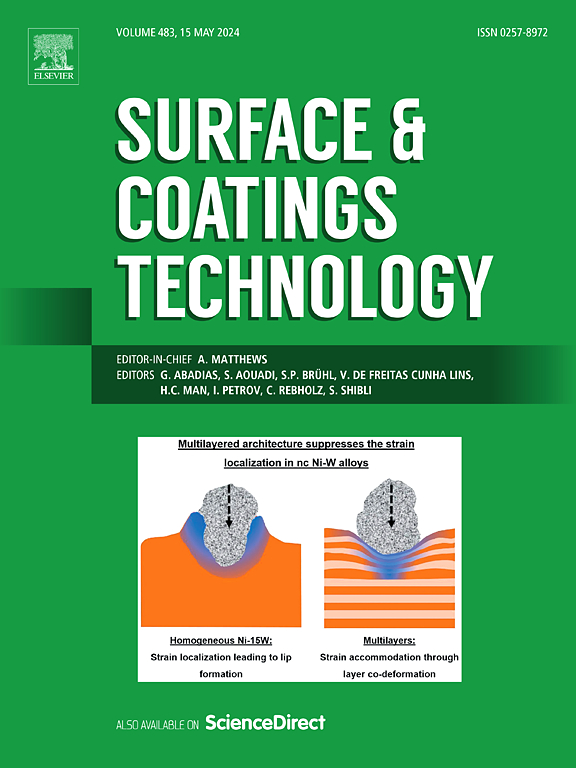Improving the corrosion resistance and mechanical properties of 2205 duplex stainless steel welded joints by laser cladding CoCrFeNiTiSi high-entropy alloys coating
IF 5.3
2区 材料科学
Q1 MATERIALS SCIENCE, COATINGS & FILMS
引用次数: 0
Abstract
Laser cladded CoCrFeNiTiSi high-entropy alloy (HEA) coatings with excellent comprehensive properties and promising application potential were proposed to improve the corrosion resistance and mechanical properties of 2205 duplex stainless steel (DSS) metal inert gas (MIG) weld joints. The microstructure, the mechanical properties, and the corrosion resistance of the HEAs were investigated systematically by way of scanning electron microscope (SEM), transmission electron microscope (TEM), quasi-static tensile test, and electrochemical test, etc. The laser cladded coatings were composited of FCC and BCC phases and characterized by fine equiaxed grains. Microstructure evolution of cladded coatings was achieved through changing the input current during laser cladding process so as to manipulated the corrosion resistance and mechanical properties, whereas variation was hardly observed in the types of phases in the coatings. As compared with the WM, the pitting corrosion resistance of laser cladded weld metal (LCWM) was significantly improved, which should be attributed to the passivation effect of Cr element in HEA materials. The excellent mechanical properties of LCWM were supposed to be originated from the strengthening effect of refined grains and the formation of BCC phase hindering dislocation movement. Coatings obtained with input current of 340 A had presented the best pitting corrosion resistance while the coatings with input current of 380 A exhibited perfect combination of improved strength and enhanced ductility. The WM was entitled excellent pitting corrosion resistance by laser cladded HEA coatings whereas the traditional soften effect of HAZ was fortunately avoided, which gave birth to a comprehensive improvement in mechanical properties and corrosion resistance.
求助全文
约1分钟内获得全文
求助全文
来源期刊

Surface & Coatings Technology
工程技术-材料科学:膜
CiteScore
10.00
自引率
11.10%
发文量
921
审稿时长
19 days
期刊介绍:
Surface and Coatings Technology is an international archival journal publishing scientific papers on significant developments in surface and interface engineering to modify and improve the surface properties of materials for protection in demanding contact conditions or aggressive environments, or for enhanced functional performance. Contributions range from original scientific articles concerned with fundamental and applied aspects of research or direct applications of metallic, inorganic, organic and composite coatings, to invited reviews of current technology in specific areas. Papers submitted to this journal are expected to be in line with the following aspects in processes, and properties/performance:
A. Processes: Physical and chemical vapour deposition techniques, thermal and plasma spraying, surface modification by directed energy techniques such as ion, electron and laser beams, thermo-chemical treatment, wet chemical and electrochemical processes such as plating, sol-gel coating, anodization, plasma electrolytic oxidation, etc., but excluding painting.
B. Properties/performance: friction performance, wear resistance (e.g., abrasion, erosion, fretting, etc), corrosion and oxidation resistance, thermal protection, diffusion resistance, hydrophilicity/hydrophobicity, and properties relevant to smart materials behaviour and enhanced multifunctional performance for environmental, energy and medical applications, but excluding device aspects.
 求助内容:
求助内容: 应助结果提醒方式:
应助结果提醒方式:


